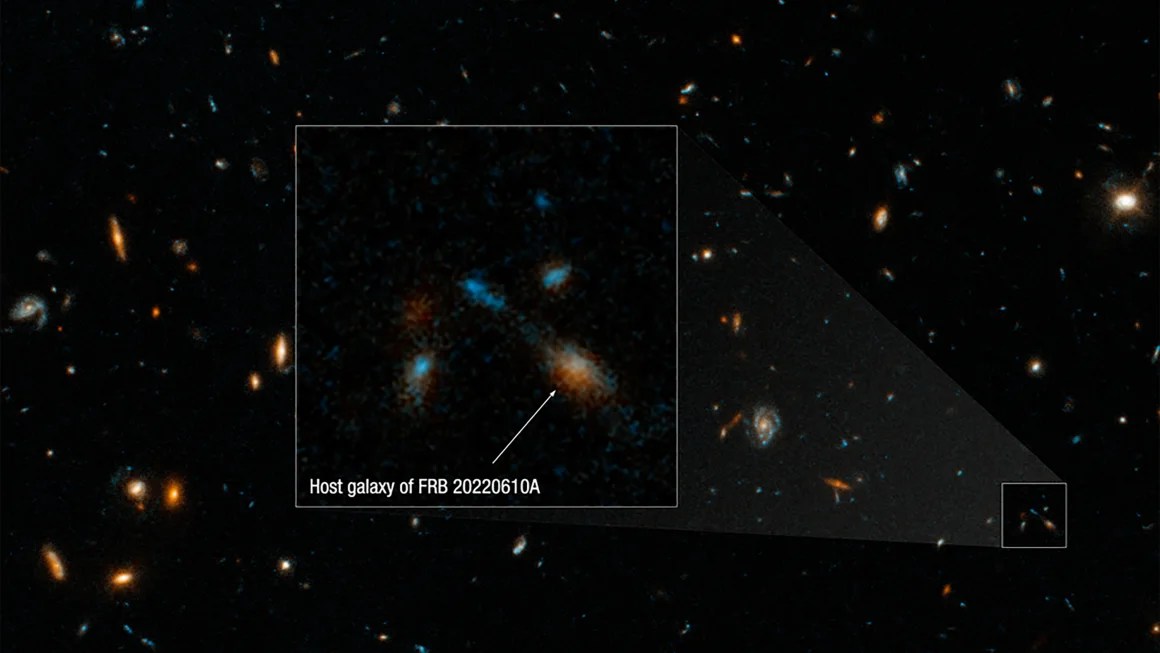(CNN) — Astronomers have traced one of the most powerful and distant fast radio bursts ever discovered to its unusual cosmic origin: a strange cluster of “bubble” galaxies. This unexpected discovery could shed more light on the causes of mysterious explosions of radio waves, which have puzzled scientists for years.
The intense signal, called FRB 20220610A, was first detected on June 10, 2022 and traveled across… 8 billion light years To reach the ground. a Light year It is the distance light travels in one year, or 5.88 trillion miles (9.46 trillion km).
Fast radio bursts (FRBs) are intense bursts of millisecond radio waves of unknown origin. The first FRB was discovered in 2007, and since then hundreds of these fast cosmic flashes have been detected from distant points in the universe.
This fast radio burst lasted less than a millisecond, but was four times more energetic than previously detected fast radio bursts. The explosion released the equivalent of our sun's energy emissions over 30 years, according to A Preliminary study Published in October.
Many fast radio bursts emit extremely bright radio waves that last for a few milliseconds at most before disappearing, making them difficult to observe.
Radio telescopes have proven useful for tracking the paths of fast cosmic flashes, so researchers used the Australian Square Kilometer Radio Telescope, or ASKAP, in Western Australia, and the European Southern Observatory's Very Large Telescope in Chile, to locate the mysterious flash. The explosion occurred.
The observations led scientists to a giant celestial spot, which was initially thought to be a single irregular galaxy or a group of three interacting galaxies.
Now, astronomers have used images from the Hubble Space Telescope to reveal that the fast radio burst came from a cluster of at least seven galaxies so close together that they could all fit inside the Milky Way.
The results were presented Tuesday at the 243rd meeting of the American Astronomical Society in New Orleans.
An unusual galactic group
The galaxies in the cluster appear to be interacting and may be merging, which could lead to a fast radio burst, according to the researchers.
“Without Hubble images, it remains a mystery whether these fast radio bursts originated in a homogeneous galaxy or in some kind of interactive system,” Alexa Gordon, lead author of the study and a doctoral student in astronomy at the School of Astronomy, said in an article. Statement of Arts and Sciences at Northwestern University.
“It's these kinds of environments — these exotic environments — that are pushing us toward a better understanding of the mystery of fast radio bursts.”
The galaxy cluster, known as the Compact Cluster, is exceptional and an example of “the densest galactic structures we know of,” said study co-author Wen-Fei Fong, associate professor of physics and astronomy at Northwestern University and Gordon's advisor. . .
When galaxies interact, they can trigger explosions of star formation, which can be related to an explosion, Gordon said.
Fast radio bursts have been detected primarily in isolated galaxies, but astronomers have also found them in globular clusters, and now in a compact group, Gordon explains.
“We need to keep finding more fast radio bursts of this type, near and far, and in all these types of environments,” he said.
Investigating the origins of fast radio bursts
Nearly 1,000 fast radio bursts have been detected since their initial discovery about two decades ago, but astronomers are still unsure of their causes.
However, many agree that compact objects, such as black holes or neutron stars, are probably dense remnants of stars that exploded. the Magnetars, or highly magnetic starsmay be the reason behind fast radio bursts, according to recent research.
Understanding the origin of fast radio bursts could help astronomers better determine what causes them to shoot across the universe.
“Although hundreds of FRB events have been detected so far, only a fraction of them have been identified with their host galaxies,” study co-author Yuexin Fic Dong said in a statement. “Within this small portion, only a few came from the dense galaxy environment, but none of them have been seen in such a compact group. Therefore, their birthplace is really rare.” Dong is a graduate researcher at the National Science Foundation and a doctoral student in astronomy at Fung's lab at Northwestern University.
Increasing knowledge of fast radio bursts could also lead to discoveries about the nature of the universe. As the jets travel through space for billions of years, they interact with cosmic matter.
“Radio waves, in particular, are sensitive to any intervening matter along the line of sight, from the location of the FRB to us,” Fung said. “This means that the waves must travel through any cloud of material around the FRB site, through the host galaxy, across the universe and finally through the Milky Way. Starting from the delay in the FRB signal, we can measure the sum of all these contributions.”
Gordon said astronomers envision increasingly sensitive ways to detect fast radio bursts in the future, which could lead to more of them being detected at greater distances.
“Ultimately, we're trying to answer the questions: What causes them? Who are their parents and what are their origins? Hubble's observations provide amazing insight into the amazing types of environments that give rise to these mysterious events,” said Fong.

“Proud web fanatic. Subtly charming twitter geek. Reader. Internet trailblazer. Music buff.”

:quality(85)/cloudfront-us-east-1.images.arcpublishing.com/infobae/TEQF6EONZRFGLLLDIDD4L2O4EE.jpg)

:quality(75)/cloudfront-us-east-1.images.arcpublishing.com/elcomercio/XU32LRAEZFDDPNVHLFU3CKVBYY.jpg)



More Stories
How to create 3D videos with my iPhone, it will be very useful even for your business
NASA discovers an anomaly in the Earth’s magnetic field that could have serious consequences for humans
Can the Earth be divided into two parts?